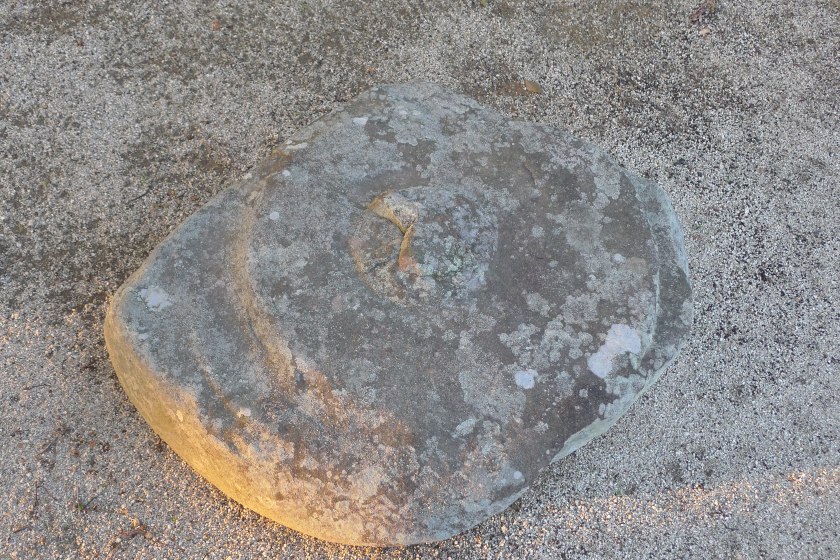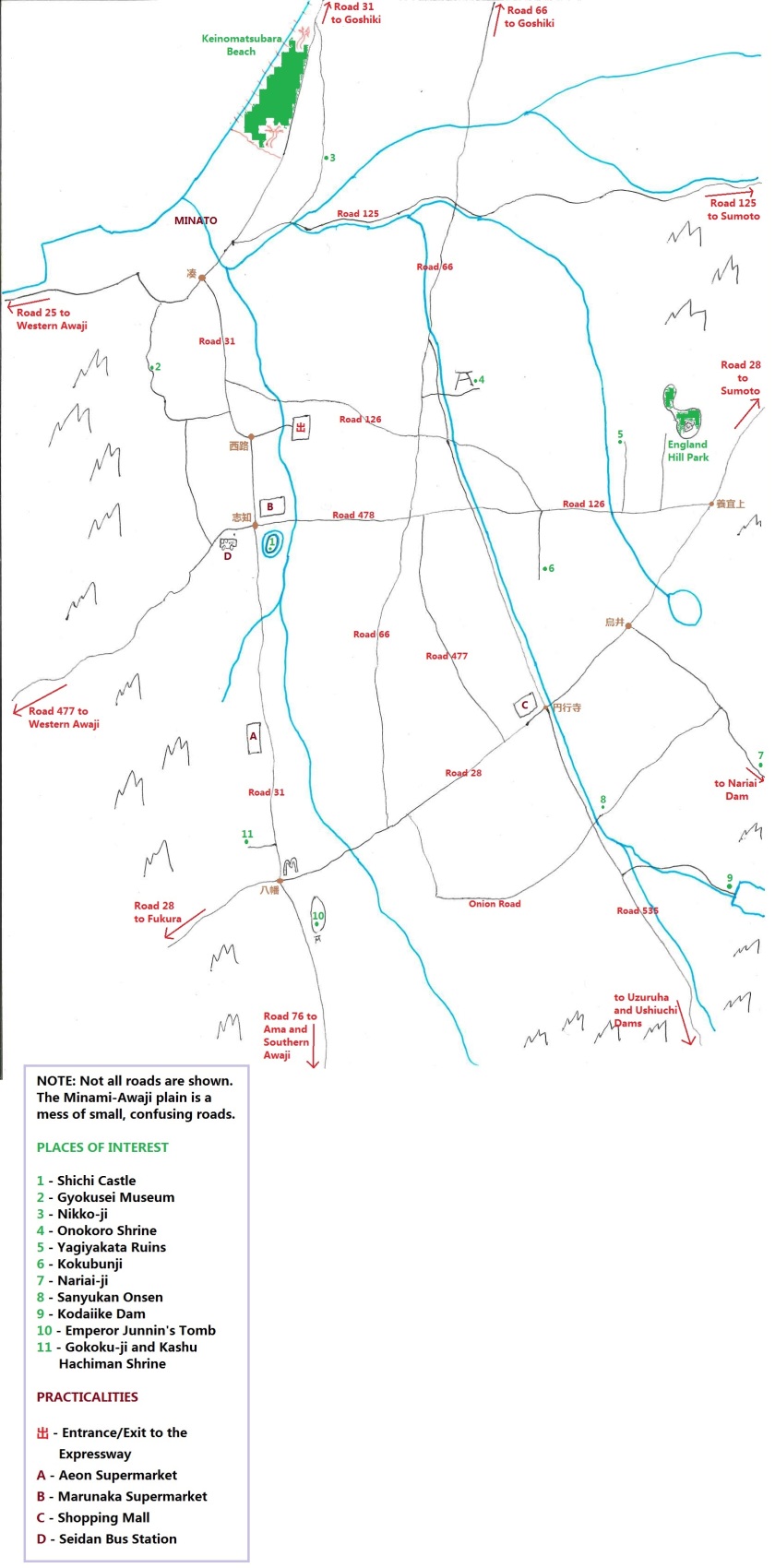ABOUT
Minami-Awaji means “southern Awaji”, and is the name of the southernmost of Awaji’s three cities. Here, however, I use the term to refer to the large plain which lies in the heart of the city (which I call Minami-Awaji-shi).
This is the largest area of flat land on the island. The historic heart and modern center of the region are inland, just north of the large range of hills which occupy the whole south of Awaji. The plain extends from here to the north-west, where it meets the Inland Sea at the town of Minato, home to a famous pine beach.
In ancient times, Minami-Awaji was Awaji’s capital, and as such it’s home to the largest selection of old temples, shrines, and historic sights anywhere on the island. Parts of the region are still referred to by the ancient name for Awaji’s southern district – Mihara.
It’s not all old history though – there are also more modern attractions as well, including the popular England Hill theme park.
Minami-Awaji lacks an obvious city center. The whole plain is a convoluted mesh of buildings and farms, and most of the sights are quite spread out, and far away from the main bus station. This area is also Awaji’s agricultural heartland, producing most of its famous onions, and raising most of Awaji’s cattle. The region looks (and smells) like a big farm. The farming is irrigated by a series of dams in the hills south of town, which make for great hiking excursions from Minami-Awaji. The dams (and more) are covered in the Southern Awaji section.

ATTRACTIONS
In the east of the plain you’ll find the Awaji Dairy Farm, a working farm where you can milk a cow, make some butter, or just sit around and moo along. Nearby lies England Hill, Awaji’s best theme park. It has everything from a petting zoo to a botanical gardens to a historic government building to a pick-your-own farm, in addition to its star attraction: koalas (English ones, perhaps).
Near to England Hill are the Yagiyakata Ruins, site of the oldest known provincial capital on Awaji. Other important historical sites in the area include Onokoro Shrine – Awaji’s second-most important shrine after Izanagi Jingu – and the island’s Kokubunji, a provincial temple founded in the 8th century. The Kokubunji houses a few original foundation stones from its former pagoda, as well as Awaji’s finest Buddhist statue – a large 14th century wooden Buddha which has been declared a national Important Cultural Property.
The plains of Minami-Awaji house many other old shrines and temples, including Gokoku-ji, Nariai-ji, Nikko-ji, and the Kashu Hachiman shrine.
South of Gokoku-ji (and very close to McDonald’s) is Emperor Junnin’s Tomb, the official commemorative tomb of an 8th century emperor who was forced to abdicate and then sent into exile on Awaji. The tomb is there for official purposes only; it’s not actually known where the emperor was buried.
Heading to the north, a few sights mark the way towards the beach at Minato: the Shichi Castle, an important stronghold in the 16th century which is today largely in ruins; and the Gyokusei Museum, commemorating the works of a locally born, 20th Century artist.
Finally, one reaches the small port town of Minato at the northern end of the plain, notable mostly for its pine beach: Keinomatsubara. The beach has been pleasantly developed, and various hotels and resorts stand nearby. The area is one of the best places on Awaji to watch the sunset over the Inland Sea.

TRANSPORT
Minami-Awaji is very spread out. It’s easiest to visit the sights by car or bicycle. There are a few confusing bus routes which cross the plain, but tourists are really better off with transport of their own here.
The only place in the region with regular direct buses off of Awaji is the Seidan bus station, inconveniently located in the west of the plain, far away from most of the main attractions. You’ll find buses from there to a variety of destinations, including Maiko, Sannomiya, and Tokushima.
If you’re desperate for local buses, here are some of the options:
- Minami-Awaji-shi Buses – The local government of Minami-Awaji-shi runs buses around the plain of Minami-Awaji, and links the plain to a few surrounding regions. These buses run to most of the sights listed here, but buses are infrequent, and the routes are designed for local residents, and not for tourists. The buses are more helpful for linking Minami-Awaji to surrounding regions: Fukura, the Naruto Strait, Ama, and other places in Western Awaji, as well as the port of Nada in Southern Awaji (useful for visiting Nushima).
- Main Island Route – Over a dozen buses a day running through the heart of Minami-Awaji, linking it to Fukura, Sumoto, Tsuna, Higashiura and Iwaya. Some buses detour off the main route to run to England Hill.
- Tsushi Route, Torikai Route, Minato Route – These routes link Minato and Keinomatsubara beach with Goshiki and Sumoto.
- Fukura Route – Provides fast buses which travel along the highway from the Shichi bus stop (close to Seidan bus station) to northern Awaji.
Minami-Awaji is the easiest place on Awaji to get lost. Road 28 runs through its heart, though there is little of interest alongside the road itself: most of the sights are in the tangle of narrow, twisting country lanes which run their way through the area’s farms. Road 31 links McDonald’s, in the south-western end of the region, with Minato, in the north-west. Most of the other roads are narrow and confusing, even by Awaji standards.
TIPS
This is one of the most interesting regions on the island, particularly for those with a bent for history. It’s also a great base from which to explore the scenic southern mountains of Awaji, while the England Hill theme park has attractions so diverse that something there is likely to appeal to just about anyone.
Most accommodation in Minami-Awaji – everything from campsites to fancy hotels – is scattered around Keinomatsubara beach. The heart of the plain, further to the south, has too many farms and not enough sea; there are good facilities, but few accommodation options.


